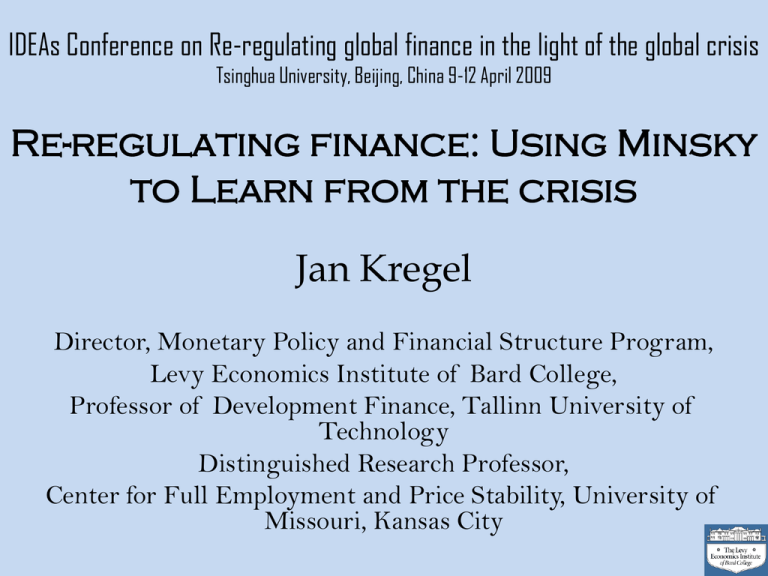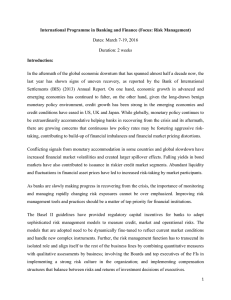Re-regulating finance: Using Minsky to Learn from the crisis Jan Kregel
advertisement

IDEAs Conference on Re-regulating global finance in the light of the global crisis Tsinghua University, Beijing, China 9-12 April 2009 Re-regulating finance: Using Minsky to Learn from the crisis Jan Kregel Director, Monetary Policy and Financial Structure Program, Levy Economics Institute of Bard College, Professor of Development Finance, Tallinn University of Technology Distinguished Research Professor, Center for Full Employment and Price Stability, University of Missouri, Kansas City Outline 1) Diagnosis as Important than Cure 2) Current Policy Based on US and Japanese 1) Fisher and Reflation in the New Deal 1) Return Prices and Incomes to Normalcy 2) Krugman & Bernanke on Japan: Liquidity Trap 1) Do ZIRP Quickly 3) Alternative Diagnosis: What Went Wrong? 1) Market as Provider of Bank Liquidity 4) How the System Works 1) Minsky Fragility of Balance Sheet Approach 5) What Can We Do To Regulate Stability 1) Macro Provision of Liquidity 2) Monetary Policy Provision of Incomes 3) Balance Sheet Intervention Fisher and Reflation in the New Deal • Monetary Expansion Will Bring Reflation (Chicago too!) • To Reverse Debt Deflation – Return Prices to NORMAL • !932 Glass-Steagall Act Allows Open Market Operations • Drives Interest Rates on Treasuries towards ZERO • Decimates Bank Profits – Policy Reversed to Save Banks • Fed FAILED to Create Money and Caused Depression (Friedman and Schwartz – Bernanke) • New Deal: • Dollar Depreciation • Price Fixing – NIRO, AAA etc • Fiscal Policy Not Keynesian until 1937 Collapse – Social Safety Net via CCC, WPA etc Zirp And Quantitative Easing • “Money, unlike other forms of government debt, pays zero interest and has infinite maturity. The monetary authorities can issue as much money as they like. Hence, if the price level were truly independent of money issuance, then the monetary authorities could use the money they create to acquire indefinite quantities of goods and assets. This is manifestly impossible in equilibrium. Therefore money issuance must ultimately raise the price level, even if nominal interest rates are bounded at zero. This is an elementary argument, but, as we will see, it is quite corrosive of claims of monetary impotence” (Bernanke 2000). Exchange Rate Policy • “the BOJ should attempt to achieve substantial currency depreciation through large open-market sales of yen. Through its effects on import-price inflation . . . , on the demand for Japanese goods, and on expectations, a significant yen depreciation would go a long way toward jump-starting the reflationary process in Japan” (Bernanke 2000, p. 160). • Mr Yen tried in July 1999 but resulted only in yen appreciation, because the United States was unwilling to allow the value of the dollar to rise. Minsky: Alternative Diagnosis • “Banking is not money lending; to lend, a money lender must have money..... A bank loan is equivalent to a bank’s buying a note that it has accepted.… When a banker vouches for creditworthiness or authorizes the drawing of checks, he need not have uncommitted funds on hand. He would be a poor banker if he had idle funds on hand for any substantial time.… Banks make financing commitments because they can operate in financial markets to acquire funds as needed; to so operate they hold assets that are negotiable in markets and hold credit lines at other banks. The normal functioning of our enterprise system depends upon a large array of commitments to finance, which do not show up as actual funds lent or borrowed, and money markets that provide connections among financial institutions that allow these commitments to be undertaken in good faith and to be honored whenever the need arises.” Business Models: Deposit Banks • Deposit Banks – Provide Payments and Safekeeping Services: Deposits – Provide Finance to Business Speculators: Loans • Lend by creating Deposits, and then Funding Loans by attracting Deposits or Borrowing from other banks – This means that banks create purchasing power ex nihilo that they lend to firms who use it to command resources – They then have to support the money creation by acquiring reserves or raising bank capital • Bank profit: charge more loan of money they don’t have than they pay for money they have to borrow • Profits = Net Interest Margin: Lending rate > borrow rate • BUT: activities and prices are regulated • Banks Originate, Fund and Hold Assets Business Models: Investment Banks • Act as Brokers for account of others – Specialists on NYSE require call lending, Charge fee for service • Act as Dealers for their own account – Require short-term financing from Deposit Banks, Charge a bid-ask spread • Provide Capital Funding for Business, Charge a percentage of the funds raised • Engage in Proprietary trading. -- Requires proprietary capital financing • Provide advisory services. == Charge fees • They Originate Assets and Distribute them in Capital Market to general public • Require Short Term Funding Business Models: Real Sector • All Business Models are Speculative Physical Production Buy inputs today to produce output for sale tomorrow Wholesale and Retail Trade and Commerce Buy outputs today for resale tomorrow • All Require Finance to purchase today something expected to be sold at a profit at some future date Profits = Sales Proceeds > Input + Finance Costs Speculative Business Models: • All depend on selling assets to finance activity • Real Sector Production – – Buy before you sell – Crisis: Excess production and inventory – Decline in product prices relative to costs • Financial Sector – – Sell Loans before you fund – Crisis: Excess sales that can’t be financed – Decline in value of assets relative to borrowing costs How Can We Regulate Stability? • Cannot be Done!! • Provision of Liquidity -– Fed to Support Financial Asset Prices BEFORE – Lending to ALL Financial Institutions (Minsky 1960) – FED did it too late, and too Aleatory – Fed Cannot Be Lender of Last Resort AND Control Economic Activity • Balance Sheet Restructuring – German Approach: Equilibrium Bonds – For Banks as in 1949 Currency Conversion, East German Mark Integration – For Households – For Value of Shortfall or Simply to Repay Mortgage Structure of SYSTEM is Important • Glass Banking Act: Determined Structure • GBL MFA: Determined Structure • Far NO Discussion of New Structure – Return to Normalcy – Save the Banks, – Concentration: Too Big To Fail/Regulate? • Regulation By Function or By Institution? – Bank Holding or Universal Bank • Different Regulation for Each • US Never Introduced Special Regulation for Holding Company Model Understand How System Works? • Government Does Not Have to Borrow To Spend • Banks Do Not Have to Fund/Reserve to Lend • Reserves Are Endogenous • Capital Is Endogenous • Both Are Pro-Cyclical • Balance Sheets Are Important: • Consumption Function • Liquidity Preference


